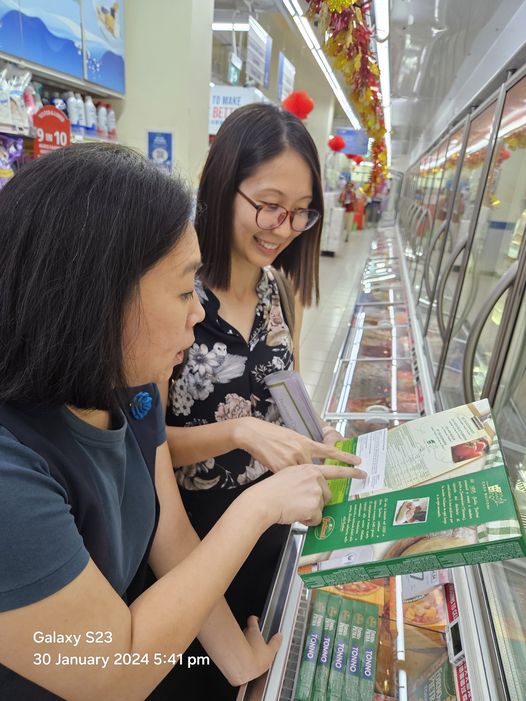
Angle: When we’re at the supermarket, we may feel overwhelmed by the amount of choices available. However, making the healthy choice doesn’t have to be difficult. Here are some tips you can keep in mind the next time you’re at a supermarket.
Why should I read food labels?
- Provide useful information to decide whether a food can fit into your daily meal plan
- Provide an idea on the nutritional value of a food and how the food can meet your nutritional requirements
What’s on a food label?
- Nutritional information panel
- Nutrient claims
- Health claims
- Ingredient list
- Date marking
- Net weight
- Usage instructions
- Manufacturer’s details
How do I read a food label?
What does serving size mean? Is it the recommended amount I should eat?
- Serving size is based on the amount of food people typically consume, rather than how much they should consume
- The serving size is not a recommendation of how much to eat or drink
- You may adjust the amount of food based on your nutritional requirements.
What should I look out for on the nutrients label? [e. what are ‘bad’ items, e.g. saturated fat, sodium etc; what are ‘good’ items]
- You may want to look out for products with lower saturated fat, trans fat and sodium content but with higher fibre content for general well-being. Saturated fat and trans fat have negative impact on our heart health. Whereas, high sodium intake has been associated with high blood pressure. On the other hand, a diet high in fibre helps to ensure smooth bowels and lower the risk of heart disease.
- If you are on a calorie-restricted diet, you may want to choose products with lower calories
- If you are diabetic, watch the carbohydrate and sugar content in the products.
- Compare 2 products by looking at the per 100g/ml nutrition information
What should I look out for on an ingredient list? [e. the common saying that you shouldn’t buy a product if you can’t pronounce the ingredients]
- You can find all the ingredients that is in the product from ingredient list.
- Ingredients are listed in descending order by weight
- The first ingredient listed is present in the highest amount, followed by the second, third and so on.
- If there is only one ingredient (e.g. rice), the ingredient list need not be present
- The names of some ingredients may differ on different ingredient lists!
- Common name for fats:
- Vegetable oil/ fat
- Dripping
- Animal fat/ oil
- Saturated fat
- Monounsaturated fat
- Polyunsaturated fat
- Trans fat
- Coconut oil
- Palm oil
- Shortening
- Copha
- Lard
- Tallow
- Butter fat
- Milk solids
- Monoglycerides
- Diglycerides
- ‘Creamed’ or ‘ Toasted’
- Common name for sugar
- Sucrose
- White or refined sugar
- Brown sugar
- Cane sugar
- Castor sugar
- Icing sugar
- Molasses
- Golden syrup
- Invert sugar
- Malt/ malt extract
- Corn syrup
- Honey
- Glucose
- Maple syrup
- Fruit juice concentrate
- Maltose
- Fructose
- Dextrose
What tips do you have to avoid temptations at the supermarket? [i.e. make a list, don’t shop in an empty stomach, etc?]
- Make a list and stick to it!
- Don’t shop when you’re hungry
- Use a basket if you don’t have much to buy
- Fill in with fresh foods first
- Be aware of the supermarket’s marketing lures
Is there anything wrong with buying frozen fruits and vegetables? Why/why not?
There is nothing wrong with buying frozen fruits and vegetables. Fresh produce may not always be available, and frozen varieties are a convenient alternative. Most fruits and vegetables are usually picked and frozen at peak ripeness. And freezing helps to preserve nutrient value. In general, evidence suggests that frozen fruits and vegetables retain a comparable vitamin, mineral, and phytochemical content to their fresh counterparts.
Are products (such as sugar-free Coke or low-fat peanut butter) labelled ‘low fat’ or ‘sugar-free’ really healthier? Why/why not?
Some of the products labelled ‘low fat’ may not be healthier as such products may be loaded with sugars. For example, low fat peanut butter contains lesser fat but it is added with sugar and the calories content is similar with natural peanut butter. Natural peanut butter is usually made from nuts which is healthier. You can opt for unsalted peanut butter to avoid excessive sodium intake.
However, some products labelled as sugar free can be healthier options. For example, sugar-free coke has no sugar in it and it does not provide any calories. It is a better alternative for people with diabetes and those who are on weight loss program. The sweetness actually comes from artificial sweetener which is generally considered safe in moderation.
What are artificial additives & should we avoid them?
Some of the common food additives include Monosodium glutamate (MSG), artificial food coloring and sodium nitrite.
MSG has been used to enhance the flavor of many processed foods. It’s safe for most people when used in moderation. People who are more sensitive may experience symptoms like headache, sweating and numbness after eating a large amount.
Artificial food coloring is used to improve the appearance of the food products. Certain food dyes have been associated with allergic reactions in some people. It is best to choose products without artificial food coloring.
Sodium nitrite is frequently added in processed meat to prevent the growth of bacteria while adding a salty flavor and giving reddish-pink color. When exposed to high heat and in the presence of amino acids, nitrites can turn into nitrosamine, a compound that is harmful to our health. Research has shown that high intake of processed meats increases the risk of colorectal cancer.
Author:
Wong Hui Xin
Founder/Principal Dietitian at Healthier U
Adjunct Lecturer at Singapore Polytechnic
